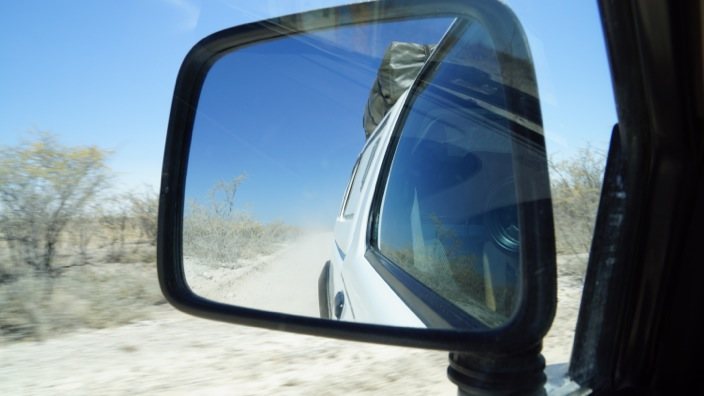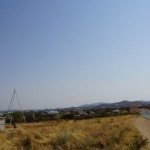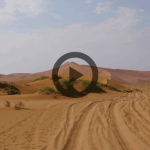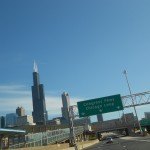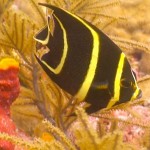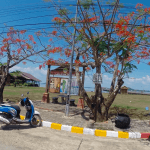From Windhoek to Etosha National Park – Road Trip across Namibia Part 1
After 2 days in Windhoek, on 6. September we finally started our road trip. In the next 17 days we wanted to see most parts of the country and therefore would have to see a lot of campsites. Our first stop was the Etosha National Park. Actually I don’t like camping very much. But if you want to see the country while traveling on a budget you rather have no other choice than sleeping in a tent. Thus I tried to look on the bright side of the whole adventure and make it as awesome as possible.
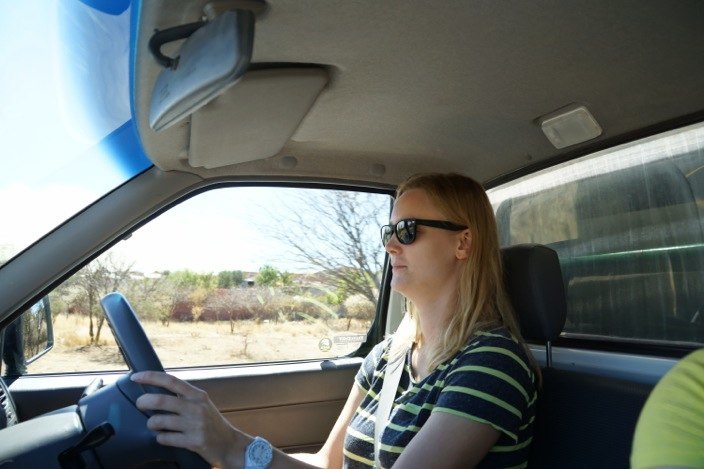
The first Detour
Of course, right from the beginning not everything ran smoothly. It started when we had forgotten our food in the fridge at the hostel. We luckily noticed after 5 minutes and went back to get our stuff, so that detour was not particularly big. But immediately afterwards, the next detour followed — and that cost us a whole hour and a half.
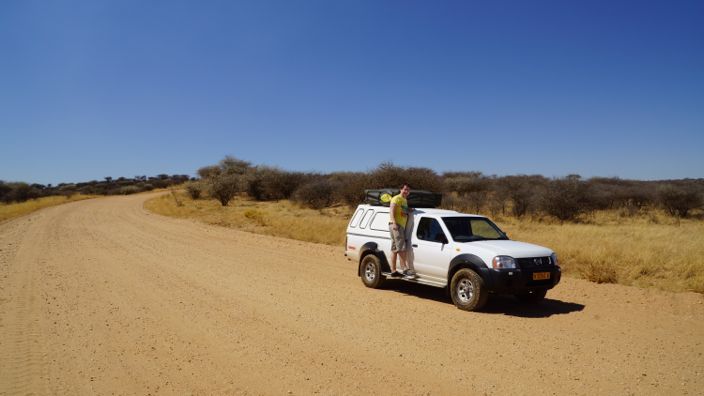
We had to take the B1 from Windhoek north. Actually that was not a difficult undertaking, because the B-roads are the largest in Namibia and are signposted everywhere. We drove from the hostel to the B6 that should cross the B1 after a few minutes. Unfortunately, we were not very good in reading signs again and just didn’t see the turn. We didn’t even notice that we drove onto the wrong road.
As the road suddenly changed from tarmac to a sand road, I wondered briefly whether we were really going the right way. We however drove undeterred until we crossed a road that wasn’t an exit of the B1 according to the map. So we finally took a closer look at the map and noticed that we went onto the wrong road in the wrong direction — namely west towards Swakopmund.
Pretty stupid, but we knew beforehand that everything would not run smoothly. So we made fun of ourselves, U-turned, and finally returned to the B1 after an hour and a half detour. But we also saw all kinds of animals on the street: little monkeys, pigs, goats, donkeys, horses and cows. In Namibia, you must be extremely careful that you don’t suddenly run over an animal with your truck — the animals always have priority!
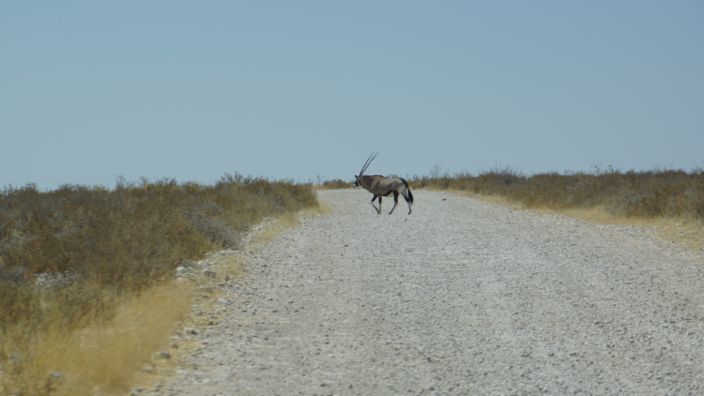
The first Night
We reached the small town of Outjo in the afternoon after driving 378 km. Outjo is around 100 km from Etosha National Park and because we had learned yesterday that it’s getting dark very quickly, we decided to spend the night in Outjo and leave early the next morning to the national park.
Supposedly, it was high season. But there were no signs to indicate that. I asked at the reception of the Etotongwe Lodge for an available campsite and the lady must have laughed her head off on the inside, but she behaved seriously and even looked in the booking system for us. In fact, we were the only campers there — and we remained the only ones.
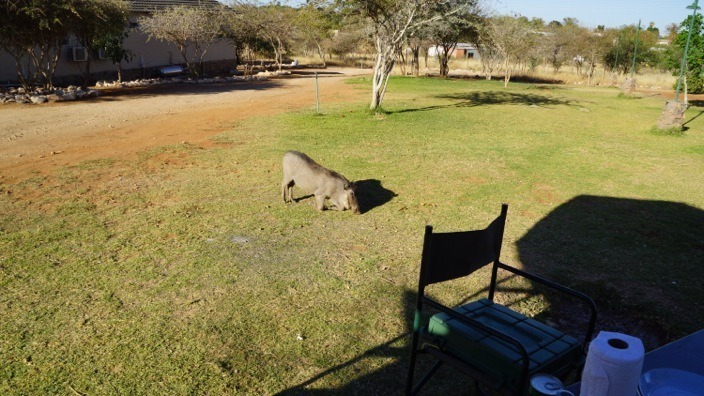
Only a warthog joined us. As the warthog crossed our way the first time, I naturally reacted like a little girl: “Oooh look, a warthog! How cute!” Within seconds, the little girl turned into a hysterical little girl, as the warthog came closer. So I yelled at Patrick that he should drive it away. Typical woman. But that warthog actually was not very nice – it wanted to steal our dinner right from the pan! It, of course, didn’t accomplish that mission. However, it didn’t give up annoying us and the next morning, it was even halfway successful.
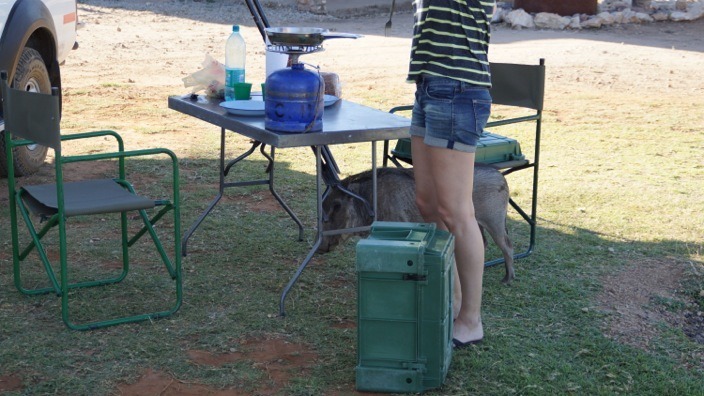
We had a box where we stored our food in. In the morning, the box was next to the car on the ground. As Patrick wasn’t looking, the warthog actually managed to make it to the box and steal the bread. I wished I had a video of what happened next — unfortunately I only know this story from Patrick’s accounts, because I was in the bathroom when the incident occurred. Anyhow, Patrick noticed the warthog rather quickly after it stole the bread because it wanted to run away as quickly as it could. Patrick then ran after the warthog and was lucky as it lost the bread bag while running. That was his chance to get the bread back. Patrick and the warthog tugged briefly at the bag and Patrick won, but lost, however, a couple of slices, which he threw to the pig as a consolation.
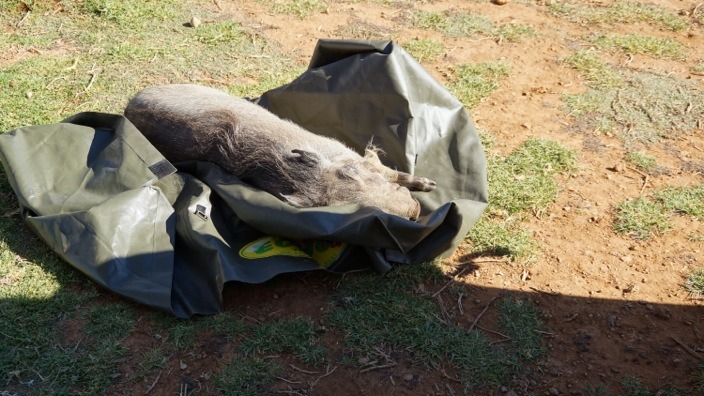
If that wasn’t enough, a little later the warthog tried to steal our tarp which was, of course, also lying on the ground. First the warthog laid down on the tarp to join us. That was, however, not long-lived because shortly afterwards, it jumped up as if stung by an adder and wanted to vamoose with the tarp. Thus, there was another battle: Man vs. Warthog — which, of course, the man won.
The first Attraction: Etosha National Park
After the stressful events in the morning, we drove to Etosha National Park through the Anderson Gate at the south end. In Namibia, you need a paid permit to enter many areas, and so, of course, for Etosha. The park costs 80 N$ per person and day plus 10 N$ per car and day. The fee can be paid at either the south or east end of the park, but not in the park itself. In addition, there is the fee for the campsite: 200 N$ per car plus 100 N$ per person and night. We also got a map of the park for 40 N$. We realized afterwards that we got a free map from the car rental, but it was already too late. All of the watering holes are marked on the map — and that is the point after all: to observe animals at the watering holes.
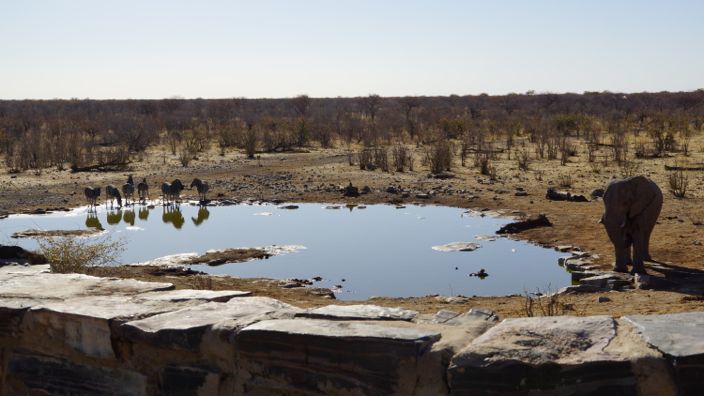
We had planned to drive to the middle of the park and spend the night at the Halali campsite (it was 202 km away from Outjo). To be sure we would have some place to sleep, we called the campsite from the Anderson Gate to reserve a place – because of high season. That was however unnecessary, because the place wasn’t completely full.
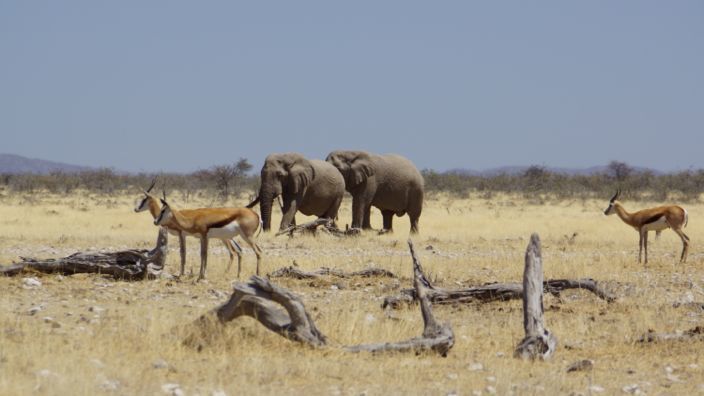
On the way to Halali, we stopped at a number of watering holes and encountered a multitude of animals: zebras, springboks, giraffes, elephants, antelopes. Experiencing these animals in the wild — to be so close — was really a great experience. I only knew a few of these animals, if any at all, from the zoo – where they’re locked-in. In Etosha, they’re within my grasp. And they cross the street from time to time. That’s why getting out of the car is forbidden in Etosha – unless it is expressly allowed by the park. But that is, actually, only on the campsites.
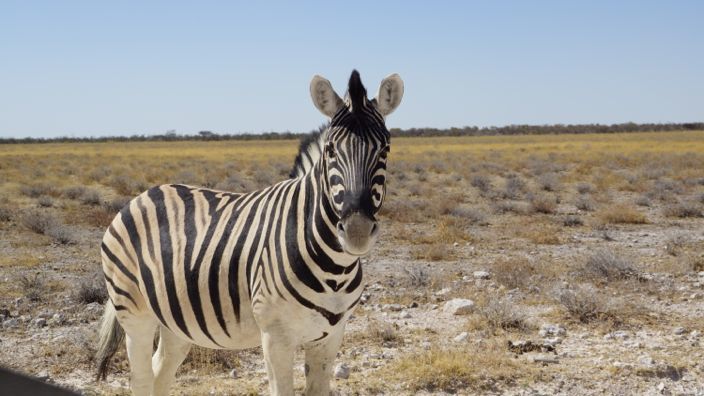
Directly at Halali is another watering hole that we could look at in the dark. Because there are signs everywhere that say everyone should be quiet, almost nobody spoke a word. And if they did, they whispered. A dozen people sat there and waited for the animals. After about a half hour, we observed the firs onet: a hyena. That was kind of crazy — an animal I still had never seen in real life. Actally they’re not as scary as the hyenas in „The Lion King“. About half an hour later a rhino came across. A rhinoceros! How cool is that? I was totally fascinated.
After an exciting day we fell asleep relatively early and after a short night we drove across the 2nd part of the park to the east end. The nights during out road trip were rather short in general – because it was either too hot in the morning or because it was too f*cking cold at night. On top of that, the other campers, if indeed they were there, made so much noise very early in the morning and we never had a chance of getting back to sleep. We were usually the last ones on the campsite — and that was around 8:00 a.m.
The drive first took us to the Etosha Lookout. There you drive just a little into the Etosha Pan and suddenly you see nothing other than white sand. This is really an incredible sight. Far and wide, there was no discoloration, there were no plants, not a single thing other than sand. It feels like you’re at the end of the world. At the Lookout, it was pretty windy — it seems to be very windy in Namibia in general.
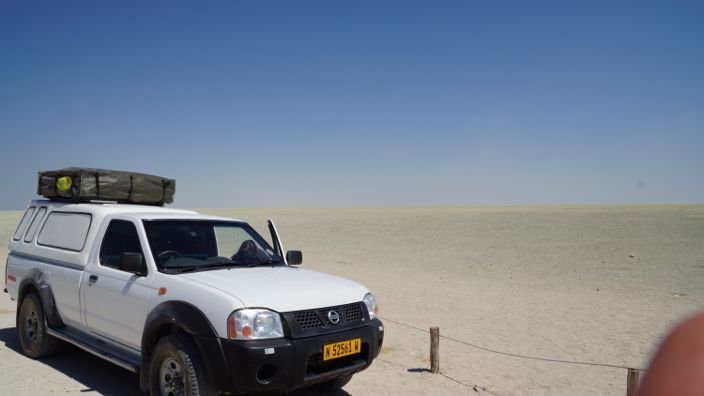
After seeing that great, big nothingness, we drove to the other watering holes. I had hoped to encounter a cheetah or another predator, but they didn’t seem to be in the vicinity of the road. Why should they – the national park is 22,270 square kilometers big. We thus saw no predators, but more zebras, giraffes, goats, and at one watering hole an entire herd of elephants.
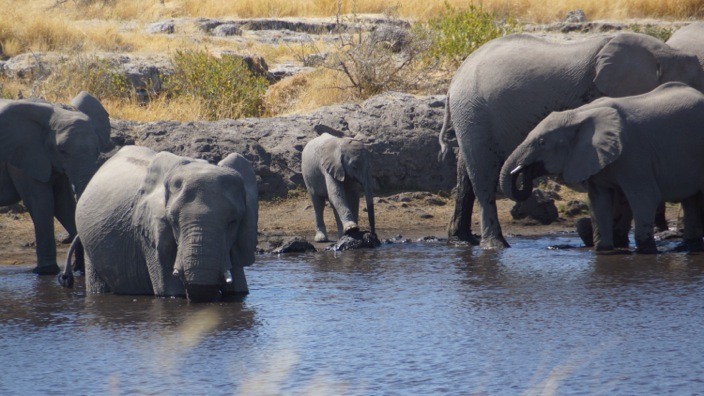
At the last watering hole, we encountered another giraffe who was daring to drink water. That’s the thing with giraffes — the neck is long, but the legs are longer. Because of that, the giraffe has to take a more unfavorable position to reach the water. If at that moment it was attacked by another animal, the giraffe would have no chance. That’s why they have to think about whether they really need to stoop down to the water.
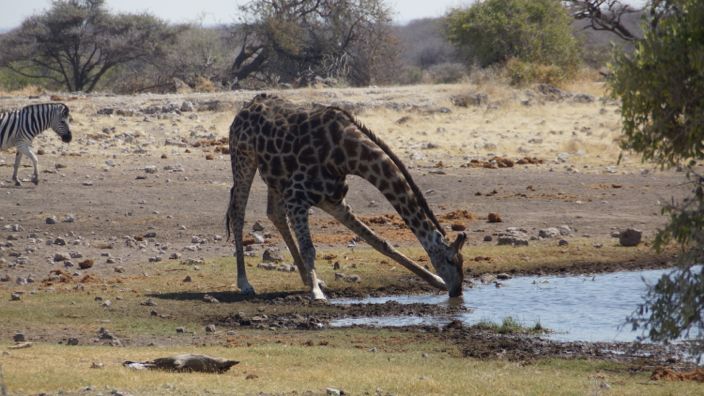
The first (and only) Fear of Death
In the early afternoon, we left Etosha again and made our way to Tsumeb where we wanted to spend the night. In Namibia, there are only 2 natural lakes — and they’re near Tsumeb, so without further ado, we turned into a very bad sidestreet to have a quick look at the lakes. The idea was not the best we ever had, because the lakes were much further away than we had thought and the signs there were so old and faded that I didn’t have a good feeling getting out of the car there in the middle of nowhere.
But instead of turning around, we drove along this road until we came onto another side road that led to a place called Otavi. Otavi was a bit closer than Tsumeb to our ultimate goal: the west coast. Thus, we decided that we could just stay there. We had, however, underestimated the scale of the map and we were on the road for an entire hour and a half before we reached Otavi. I was afraid that we were completely wrong because there was really nothing at all aside the street except fields. There was a sign about a farm from time to time and we saw cows now and then, but generally there was nothing. Thanks to the whole panicmongering in Windhoek and in our guidebook at this point – everyone says you should never drive at night, you always need to keep doors closed, and should turn around if a tree trunk lies crosswise on the street and people are standing next to it.
I was so afraid that I did not speak a word from the lakes to Otavi. When we finally arrived in Otavi, the mood unfortunately didn’t brighten up. The place was also very scary and we were only starting our journey, so I couldn’t figure out whether the city was now extremely scary or really just like one another. Anyhow, I didn’t want to spend the night there and so we drove further towards Tsumeb. By then, we were still 60 km away and the sun was already setting, so I was racing like a maniac and Patrick was in fear of death.
On that day, I learned 2 things: The first is that I make no more detours, as the guidebook described the trip to the lakes a a little detour. The second is that we take no more coffee in our thermoses, because that was the second day in a row where we didn’t touch it on the way. What a waste of petrol and coffee!
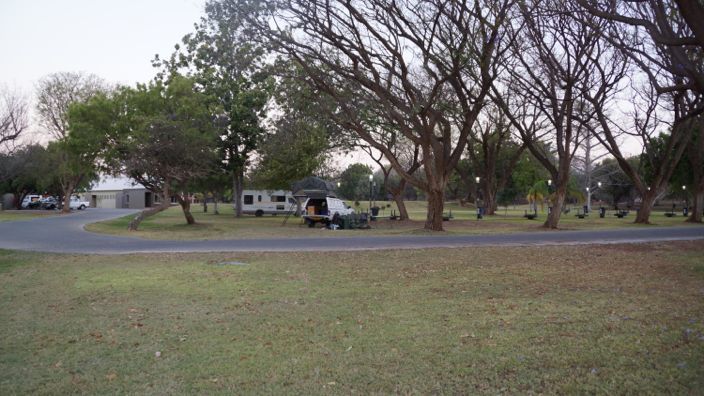
Relaxing for the first Time
Shortly before we reached Tsumeb, we stopped at a campsite which was unfortunately full because a complete class had made a trip there. Next, we drove to the Kupferquelle campsite in Tsumeb. We took a flyer from Kupferquelle at Joe’s Beerhouse and the place looked very good. Here we were again alone with only 2 other campers and we were able to finally relax shortly before it became pitch-dark. After the nerve-wracking drive we decided to stay at the place for 2 nights. The campsite had a pool, washing machines and a restaurant and was additionally equipped with a lawn. For 230 N$ / night we couldn’t really complain and booked 2 nights before we enjoyed a huge steak for a very small price at the restaurant.
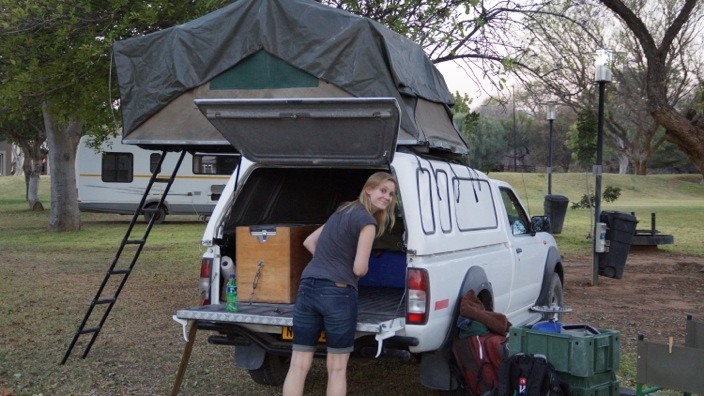
The next day we only relaxed and took a look on our photos we had shot up to that point. And on the following day, 10. September, we started the next part of our road trip with high spirits and washed clothes.

